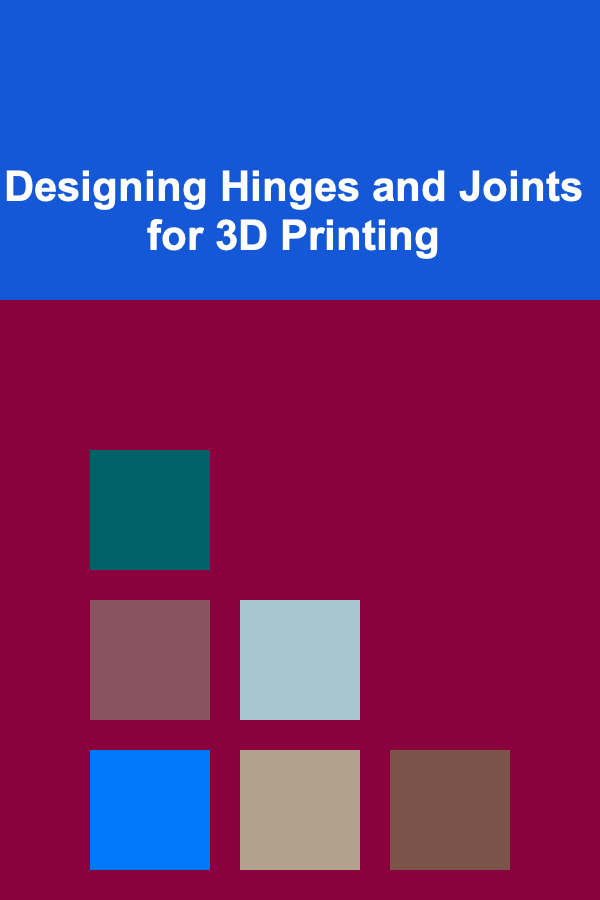
Designing Hinges and Joints for 3D Printing
ebook include PDF & Audio bundle (Micro Guide)
$12.99$5.99
Limited Time Offer! Order within the next:

3D printing has revolutionized prototyping and manufacturing, allowing for the creation of complex geometries and intricate designs with relative ease. However, designing functional parts that involve movement, such as those incorporating hinges and joints, requires careful consideration of the technology's limitations and strengths. This article provides an in-depth exploration of designing effective hinges and joints specifically for 3D printing, covering material selection, design principles, print orientation, post-processing, and various types of hinges and joints suitable for different applications. It aims to equip designers and engineers with the knowledge necessary to create durable, functional, and printable mechanisms.
Understanding 3D Printing Considerations for Hinges and Joints
Before diving into specific designs, it's crucial to understand how 3D printing processes impact the functionality of hinges and joints. Key considerations include:
Material Selection
The material used for 3D printing dramatically affects the strength, flexibility, and durability of hinges and joints. Common materials include:
- PLA (Polylactic Acid): PLA is a biodegradable thermoplastic known for its ease of printing and low cost. It's suitable for prototyping and less demanding applications where flexibility and high temperature resistance are not critical. However, PLA can be brittle and prone to cracking under stress, particularly around hinge points.
- ABS (Acrylonitrile Butadiene Styrene): ABS offers better impact resistance and higher temperature resistance than PLA, making it suitable for more functional parts. It is also more flexible than PLA, making it a better choice for living hinges. However, ABS requires a heated bed and enclosed build chamber to prevent warping during printing.
- PETG (Polyethylene Terephthalate Glycol-modified): PETG combines the ease of printing of PLA with the strength and durability of ABS. It boasts good layer adhesion, is food-safe (check specific filament certifications), and has a higher impact resistance than PLA. This makes it a versatile choice for various hinge and joint applications.
- Nylon (Polyamide): Nylon offers excellent strength, flexibility, and wear resistance. It's ideal for hinges and joints that require high durability and low friction. However, nylon is hygroscopic (absorbs moisture from the air), which can affect printing quality. It often requires drying before printing and careful storage.
- TPU (Thermoplastic Polyurethane): TPU is a flexible filament that can be used to create flexible hinges and joints. Its elasticity allows for large degrees of movement and impact absorption. It's often used for living hinges and parts that need to bend or flex repeatedly. Printing TPU can be challenging, requiring slower print speeds and careful retraction settings.
- Resins (SLA/DLP/MSLA): Resin 3D printing can achieve very high resolution and smooth surfaces, making it suitable for intricate hinge designs. However, resin parts tend to be more brittle than parts printed with FDM materials. Some resins are specifically formulated to be more flexible and durable. Post-curing is essential for resin parts to achieve their final properties.
The choice of material should be based on the specific requirements of the application, including the load the hinge or joint will bear, the required range of motion, the operating temperature, and the desired lifespan.
Print Orientation and Layer Adhesion
Print orientation significantly affects the strength and durability of 3D printed parts, particularly hinges and joints. Layers are inherently weaker than the material itself, so orienting the part to minimize stress on layer lines is crucial. Consider these guidelines:
- Minimize Stress on Layer Lines: Orient the part so that the force applied to the hinge or joint is perpendicular to the layer lines whenever possible. This will distribute the stress across multiple layers rather than relying on the adhesion between layers.
- Consider Support Structures: Overhanging features require support structures, which can leave marks on the finished part and potentially weaken the hinge point. Optimize the orientation to minimize the need for supports in critical areas.
- Vertical vs. Horizontal Orientation: Printing a hinge vertically can result in weaker layer adhesion along the hinge axis, making it more prone to breakage. Printing horizontally can improve strength but may require more support structures. The best orientation depends on the hinge design and the expected loading conditions.
- Layer Height: Lower layer heights generally result in stronger and smoother parts. However, they also increase printing time. Finding the optimal layer height is a balance between strength and efficiency.
Tolerance and Clearance
3D printing processes have inherent limitations in accuracy. It's essential to design hinges and joints with sufficient tolerance and clearance to allow for movement. This means leaving small gaps between mating parts to prevent them from fusing together during printing.
- Typical Tolerance: A general rule of thumb is to allow a clearance of at least 0.1-0.2mm between moving parts. This can vary depending on the printer, material, and desired precision.
- Testing: It's always recommended to print test pieces to determine the optimal clearance for a specific printer and material combination.
- Shrinkage and Warping: Some materials, such as ABS, are prone to shrinkage and warping during printing, which can affect the fit of hinges and joints. Account for these effects in the design.
Support Structures and Removal
As mentioned earlier, support structures are often necessary to print overhanging features. Removing these supports can be challenging and can leave marks on the finished part. Consider these strategies:
- Design for Minimal Supports: Optimize the part orientation to minimize the need for supports, particularly in critical areas like the hinge axis.
- Easy-to-Remove Supports: Use support materials that are easy to remove, such as soluble supports (e.g., PVA for PLA).
- Careful Removal: Remove supports carefully using appropriate tools to avoid damaging the part.
- Post-Processing: Sanding or filing may be necessary to smooth out areas where supports were removed.
Types of Hinges and Joints for 3D Printing
There are several types of hinges and joints that can be effectively 3D printed. The choice depends on the application, required range of motion, and desired strength and durability.
Living Hinges
Living hinges are thin, flexible sections of material that allow two parts to bend relative to each other. They are commonly used in 3D printing because they can be printed as a single piece, eliminating the need for assembly.
-
Design Considerations:
- Material: Flexible materials like TPU, nylon, or polypropylene (PP) are ideal for living hinges. ABS can also be used, but it may be more prone to cracking.
- Thickness: The thickness of the living hinge is crucial. Too thick, and it won't bend easily; too thin, and it will break. Experimentation is key, but a starting point is around 0.2-0.5mm for flexible materials.
- Length: The length of the living hinge affects its flexibility and durability. Longer hinges generally offer greater flexibility but may be less durable.
- Stress Concentration: Avoid sharp corners or edges in the living hinge design, as these can concentrate stress and lead to failure. Round the corners to distribute the stress more evenly.
- Hinge Geometry: Different hinge geometries can affect the bending characteristics. A simple straight hinge is the most common, but other options include V-shaped hinges and hinges with relief cuts to improve flexibility.
-
Example Applications: Boxes with hinged lids, snap-fit closures, flexible straps.
-
Design Example:
To create a simple living hinge in a CAD program, draw two rectangular parts that need to be connected. Then, create a thin rectangular section connecting the two parts. This section will be the living hinge. Round the corners of the hinge section with a small fillet to reduce stress concentration. The thickness of this section is critical and should be tested with different materials.
Pin Hinges
Pin hinges consist of two or more interlocking parts that are connected by a pin or rod. They offer greater strength and durability than living hinges, but they require assembly.
-
Design Considerations:
- Pin Diameter: The pin diameter should be large enough to withstand the expected load but small enough to allow for smooth rotation.
- Hole Tolerance: The hole for the pin should have sufficient clearance to allow for easy insertion and rotation. A clearance of 0.1-0.2mm is generally recommended.
- Pin Retention: The pin needs to be securely retained in the hinge. Options include friction fit, snap-fit, or using a retaining clip.
- Hinge Leaf Thickness: The thickness of the hinge leaves (the parts that connect to the pin) should be sufficient to withstand the load.
- Material: Strong materials like ABS, PETG, or nylon are recommended for pin hinges.
-
Example Applications: Doors, lids, hinges for tools, and structural components.
-
Design Example:
A typical pin hinge consists of two interlocking leaves, each with a cylindrical protrusion containing a hole. When the leaves are aligned, the holes form a continuous channel through which the pin can be inserted. Design the pin slightly longer than the width of the hinge to allow for easy gripping. Consider adding a chamfer to the pin ends for easier insertion.
Snap-Fit Joints
Snap-fit joints are designed to be assembled by pressing two parts together until they "snap" into place. They are a quick and easy way to create joints without the need for fasteners.
-
Design Considerations:
- Cantilever Beam: The most common type of snap-fit joint uses a cantilever beam with a hook or detent that engages with a corresponding feature on the mating part.
- Deflection: The cantilever beam needs to be able to deflect sufficiently to allow the hook to pass over the mating feature. The amount of deflection depends on the geometry of the hook and the material properties.
- Interference Fit: The hook should create a slight interference fit with the mating feature to ensure a secure connection.
- Material: Flexible materials like ABS, PETG, or nylon are suitable for snap-fit joints. The material needs to be able to withstand repeated bending without breaking.
- Draft Angle: Add a draft angle to the surfaces that slide against each other during assembly to reduce friction and prevent binding.
-
Example Applications: Enclosures, cases, boxes, and other applications where quick assembly is desired.
-
Design Example:
Create a cantilever beam extending from one part. At the end of the beam, add a hook that will engage with a slot or recess on the mating part. The hook should have a ramped surface to allow it to easily slide over the mating feature. The ramped surface should be at an angle of approximately 30-45 degrees.
Ball-and-Socket Joints
Ball-and-socket joints allow for a wide range of motion in multiple directions. They consist of a spherical ball that fits into a concave socket.
-
Design Considerations:
- Clearance: The ball should have sufficient clearance within the socket to allow for smooth movement. However, too much clearance can result in excessive play.
- Retention: The ball needs to be retained within the socket. Options include using a retaining ring, a snap-fit mechanism, or a friction fit.
- Material: Strong and wear-resistant materials like ABS, PETG, or nylon are recommended for ball-and-socket joints.
- Surface Finish: A smooth surface finish on the ball and socket will reduce friction and improve the joint's performance.
-
Example Applications: Robotics, camera mounts, adjustable supports, and other applications where multi-directional movement is required.
-
Design Example:
Create a sphere and a corresponding socket. The socket should be slightly larger than the sphere to allow for movement. Design a method for retaining the sphere within the socket, such as a retaining ring that snaps into place. Consider adding a small amount of grease to the joint to reduce friction.
Threaded Joints
Threaded joints use screws or bolts to connect two or more parts together. They are a strong and reliable way to create joints, but they require the use of fasteners.
-
Design Considerations:
- Thread Size: Choose an appropriate thread size based on the expected load.
- Hole Size: The hole for the screw or bolt should be slightly larger than the fastener's diameter to allow for easy insertion.
- Threaded Inserts: For greater strength, consider using threaded inserts. These are metal inserts that are embedded into the 3D printed part and provide a more durable thread.
- Material: Strong materials like ABS, PETG, or nylon are recommended for threaded joints.
-
Example Applications: Structural components, enclosures, and other applications where a strong and reliable joint is required.
-
Design Example:
Create two parts that need to be connected. In one part, create a hole that is slightly larger than the diameter of the screw or bolt that will be used. In the other part, create a threaded hole that matches the screw or bolt. Consider using threaded inserts in the part with the threaded hole for increased strength.
Advanced Design Techniques
Beyond the basic types of hinges and joints, several advanced design techniques can improve their performance and durability.
Stress Relief Features
Adding stress relief features, such as fillets and chamfers, can help to distribute stress more evenly and prevent cracking, especially in living hinges and snap-fit joints.
- Fillets: Round the corners of sharp edges to reduce stress concentration.
- Chamfers: Bevel the edges of holes and other features to make them easier to assemble and reduce stress.
- Notches: Add small notches or slots to the hinge to allow it to bend more easily and reduce stress on the material.
Topology Optimization
Topology optimization is a computational technique that can be used to optimize the shape of a part to minimize weight and maximize strength. This can be particularly useful for designing hinges and joints that need to be both strong and lightweight.
Lattice Structures
Lattice structures are networks of interconnected struts that can be used to fill the interior of a part. They offer a good balance of strength and weight and can be used to reinforce hinges and joints.
Variable Density Printing
Variable density printing allows you to control the infill density of different areas of a part. This can be used to increase the strength of critical areas, such as the hinge axis, while reducing the weight of less critical areas.
Post-Processing Techniques
Post-processing techniques can be used to improve the surface finish, strength, and durability of 3D printed hinges and joints.
Sanding and Polishing
Sanding and polishing can be used to smooth out the surface of a part and remove any imperfections left by the printing process. This can be particularly important for hinges and joints that require smooth movement.
Chemical Smoothing
Chemical smoothing involves exposing the part to a solvent that melts the surface of the material, creating a smoother finish. This technique is commonly used for ABS parts.
Coating
Coating a part with a protective layer, such as paint or epoxy, can improve its resistance to wear, corrosion, and UV damage.
Heat Treatment
Heat treatment can be used to improve the strength and durability of some 3D printed materials. This involves heating the part to a specific temperature and then cooling it slowly.
Troubleshooting Common Problems
Designing hinges and joints for 3D printing can be challenging. Here are some common problems and their solutions:
- Hinge Breaks Easily:
- Problem: The hinge is too thin, the material is too brittle, or there are stress concentrations.
- Solution: Increase the hinge thickness, use a more flexible material, add fillets to sharp corners, or re-orient the print to better align with layer adhesion.
- Joint is Too Stiff:
- Problem: There is not enough clearance between the moving parts, or the surface finish is too rough.
- Solution: Increase the clearance between the parts, use a smoother print setting, or post-process the joint to improve the surface finish.
- Parts Fuse Together During Printing:
- Problem: There is not enough clearance between the parts, or the printing temperature is too high.
- Solution: Increase the clearance between the parts, lower the printing temperature, or use a cooling fan.
- Support Structures are Difficult to Remove:
- Problem: The support structures are too dense, or they are attached to critical areas of the part.
- Solution: Use a different support material, reduce the support density, or re-orient the print to minimize the need for supports.
Conclusion
Designing effective hinges and joints for 3D printing requires a thorough understanding of the technology's strengths and limitations, careful material selection, attention to design principles, and appropriate post-processing techniques. By considering the factors discussed in this article, designers and engineers can create functional, durable, and printable mechanisms that meet the specific requirements of their applications. Experimentation and iteration are key to finding the optimal designs for different materials and printing processes. As 3D printing technology continues to advance, new materials and techniques will emerge, further expanding the possibilities for creating complex and innovative hinges and joints.
Reading More From Our Other Websites
- [Home Pet Care 101] How to Maintain Your Pet's Health with Regular Vet Visits
- [Home Budget 101] How to Cut Energy Costs with Budget-Friendly Home Solutions
- [Organization Tip 101] How to Create a Garden Maintenance Schedule
- [Home Lighting 101] Best Lighting for Home Offices: Creating a Productive and Comfortable Workspace
- [Organization Tip 101] Budget-Friendly Drywall Hole Patching Tips for Homeowners
- [Personal Care Tips 101] How to Use Yoga for Stress Relief
- [Home Security 101] How to Evaluate the Best Wireless Alarm System for Your Lifestyle
- [Personal Investment 101] How to Create a Portfolio Review Checklist for Investors
- [Rock Climbing Tip 101] The Evolution of Competitive Climbing: From Bouldering to the Olympic Stage
- [Home Maintenance 101] How to Care for Your Home's Lawn Mower to Keep it Running Smoothly

Exploring Freelance Opportunities for Deep Learning and Passive Income
Read More
How to Earn Passive Income by Selling Pre-trained Deep Learning Models
Read More
How to Use AI in Natural Language Processing
Read More
Start Here: The Ultimate Guide to Learning Chinese
Read More
How to Support International Treaties for Wildlife
Read More
Designing Professional Resumes and Portfolios: A Comprehensive Guide
Read MoreOther Products

Exploring Freelance Opportunities for Deep Learning and Passive Income
Read More
How to Earn Passive Income by Selling Pre-trained Deep Learning Models
Read More
How to Use AI in Natural Language Processing
Read More
Start Here: The Ultimate Guide to Learning Chinese
Read More
How to Support International Treaties for Wildlife
Read More